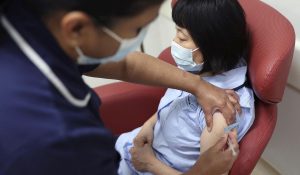As California’s latest coronavirus surge spreads at a record-setting pace, state officials on Monday unveiled a new cell phone app aimed at helping Californians track their exposure to the virus.
Starting Thursday, Californians will be able to opt into the new app — dubbed CA Notify — and receive notifications on their cell phones informing them if they have been in close proximity to someone who has tested positive for the virus.
California joins more than a dozen states, including New York, Michigan and Washington, to launch exposure notification apps in recent months.
“Even if we don’t have tens of millions of people that participate in this program, the more people that participate in it, the more effective this program can be,” Newsom said during a news briefing Monday. “Again, (this is) another tool in our toolkit in terms of impacting the spread and transmission rate of this virus.”
The tool, which uses Bluetooth technology to exchange codes between nearby phones, was developed in partnership with Google and Apple and piloted on the campuses of the University of California, San Diego and the University of California, San Francisco.
Unlike a GPS-operated notification system which caused significant public outcry over privacy concerns at the beginning of the pandemic, state officials vow that the Bluetooth system protects users’ data privacy by refraining from revealing a user’s identity or location.
“That’s why we’ve been frankly a little stubborn and kept our eyes wide open in terms of this technology,” Newsom said. “We wanted to take our time, reflect on this technology and to be secure in our confidence that what we were promoting, what we were saying here today, is indeed accurate.”
In order to receive notifications, Californians with Androids must download the CA Notify app, which will be available on Thursday from the Google Play Store, and allow notifications through the app. iPhone users can merely sign up for the notifications through their phone’s settings without downloading an app.
When a person tests positive for COVID-19, the California Department of Public Health will send a verification code to plug into the CA Notify app. Once the code is entered, it will trigger an alert to the phones of people who may have been in close proximity — within 6 feet of that individual for 15 minutes or more — in the past 14 days.
State officials say the new app will help curb the alarming rate of spread of COVID-19 across California by giving residents more timely information about exposure in order to help them make more responsible decisions such as self-quarantining and testing following potential exposure.
“Every day that is saved in alerting others of a possible exposure is a day that a possibly infectious person can begin self-quarantine and reduce the spread,” California Health and Human Services Secretary Dr. Mark Ghaly said in a news release. “This technology is another way for Californians to take proactive steps to keep themselves, their loved ones and their communities safe.”
Cases and hospitalizations have spiked at an alarming rate in California since the Thanksgiving holiday weekend. For the first time, the state is averaging 20,000 cases per day over the past week, a rate five times higher than at the start of November. More Californians are hospitalized with COVID-19 than ever before, numbering nearly 10,000, as of Saturday, with more than 2,200 in the ICU, according to the latest data from the state.
As of Monday, the rate of tests coming back with positive results over the past seven days is average 10.7% — more than double the positivity rate seen just one month ago.
The state’s new region-by-region stay-at-home order took effect Sunday night in the Southern California and San Joaquin Valley regions, where the capacity of intensive care units fell to 10.9% and 6.3% respectively, according to state data. Meanwhile, public health officials in some parts of the Bay Area counties — San Francisco, Santa Clara, Contra Costa, Alameda and Marin counties — decided to move faster than the state order and adopt the new restrictions starting this week despite 25.7% of regional ICU beds still open, which is well above the 15% threshold.
Staff writer Evan Webeck contributed to this story.
This story will be updated.

















